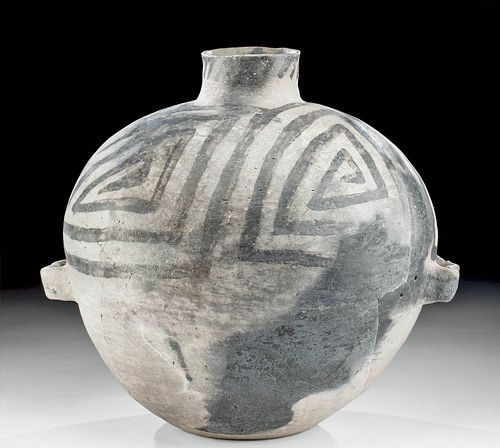Impressive Prehistoric Anasazi Chaco Pottery Olla
Lot 214
About Seller
Artemis Gallery
686 S Taylor Ave, Ste 106
Louisville, CO 80027
United States
Selling antiquities, ancient and ethnographic art online since 1993, Artemis Gallery specializes in Classical Antiquities (Egyptian, Greek, Roman, Near Eastern), Asian, Pre-Columbian, African / Tribal / Oceanographic art. Our extensive inventory includes pottery, stone, metal, wood, glass and textil...Read more
Categories
Estimate:
$5,500 - $8,000
Absentee vs Live bid
Two ways to bid:
- Leave a max absentee bid and the platform will bid on your behalf up to your maximum bid during the live auction.
- Bid live during the auction and your bids will be submitted real-time to the auctioneer.
Bid Increments
| Price | Bid Increment |
|---|---|
| $0 | $25 |
| $300 | $50 |
| $1,000 | $100 |
| $2,000 | $250 |
| $5,000 | $500 |
| $10,000 | $1,000 |
| $20,000 | $2,500 |
| $50,000 | $5,000 |
| $100,000 | $10,000 |
| $200,000 | $20,000 |
About Auction
By Artemis Gallery
Jun 10, 2021
Set Reminder
2021-06-10 10:00:00
2021-06-10 10:00:00
America/New_York
Bidsquare
Bidsquare : Exceptional Antiquities | Asian | Ethnographic
https://www.bidsquare.com/auctions/artemis-gallery/exceptional-antiquities-asian-ethnographic-7012
Museum-worthy examples of Egyptian, Greek, Roman, Viking, Near Eastern, Far East / Asian, Pre-Columbian, African / Tribal, Oceanic, Native American, Spanish Colonial, Russian, Fossils, Ancient Jewelry, Fine Art, so much more! Artemis Gallery info@artemisgallery.com
Museum-worthy examples of Egyptian, Greek, Roman, Viking, Near Eastern, Far East / Asian, Pre-Columbian, African / Tribal, Oceanic, Native American, Spanish Colonial, Russian, Fossils, Ancient Jewelry, Fine Art, so much more! Artemis Gallery info@artemisgallery.com
- Lot Description
Native American, Southwestern United States, Four Corners region, New Mexico, Chaco Canyon area, Pueblo I/II (Anasazi) period, ca. 900 to 1030 CE. A magnificent, massive pottery bowl presenting with a flat, circular base, a bulbous body, a narrow neck, and an annular rim. A pair of rectangular, applied handles flanks the voluminous body of this remarkable vessel. The top half of the jar is beautifully adorned with black-painted triangular spirals on a light grey ground, as a black horizontal band coats the rim with a series of vertical diagonal striations adorning the neck. Pottery played an important role in Anasazi culture and included both utilitarian and decorative pieces that could be traded with neighboring communities for food or other goods. Anasazi pottery was made by hand coiling clay, then smoothing the surface and painting with designs before firing. This petite pitcher is a lovely example created via this technique! Size: 14.5" in diameter x 14" H (36.8 cm x 35.6 cm)
The Red Mesa Black-on-White pottery style seen here was most famously excavated at the great Anasazi city of Chaco Canyon.
This piece has been searched against the Art Loss Register database and has been cleared. The Art Loss Register maintains the world’s largest database of stolen art, collectibles, and antiques.
Provenance: ex-private Honolulu, Hawaii, USA collection; ex-private southern California, USA collection
All items legal to buy/sell under U.S. Statute covering cultural patrimony Code 2600, CHAPTER 14, and are guaranteed to be as described or your money back.
A Certificate of Authenticity will accompany all winning bids.
We ship worldwide and handle all shipping in-house for your convenience.
#163400Repaired from several pieces with break lines visible and ten apertures from repair. Expected nicks/chips and abrasions commensurate with age and use. Some minor restoration to rim. Otherwise, excellent with lovely remaining pigments.Condition
- Shipping Info
-
All shipping is handled in-house for your convenience. Your invoice from Artemis Gallery will include shipping calculation instructions. If in doubt, please inquire BEFORE bidding for estimated shipping costs for individual items.
-
- Buyer's Premium



 EUR
EUR CAD
CAD AUD
AUD GBP
GBP MXN
MXN HKD
HKD CNY
CNY MYR
MYR SEK
SEK SGD
SGD CHF
CHF THB
THB















